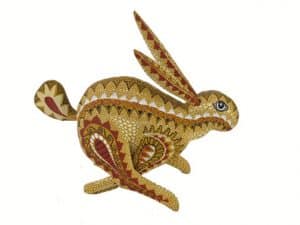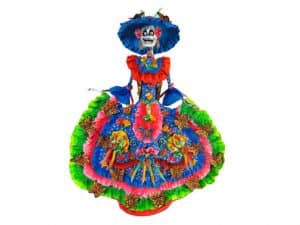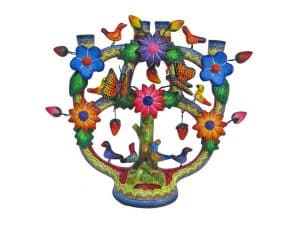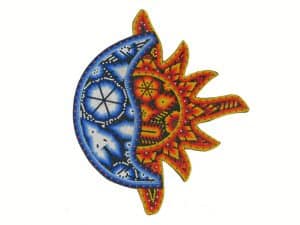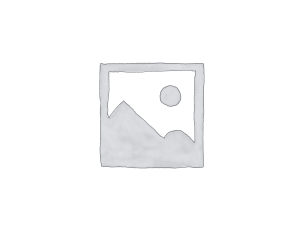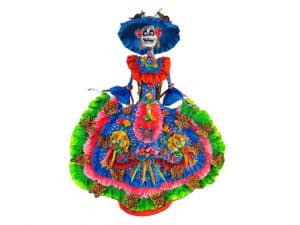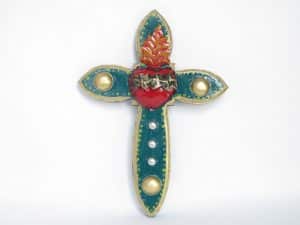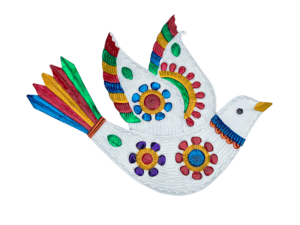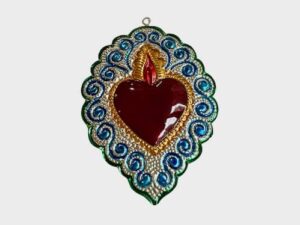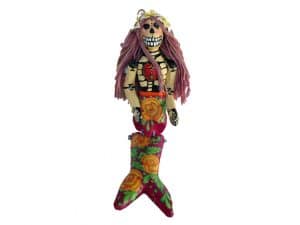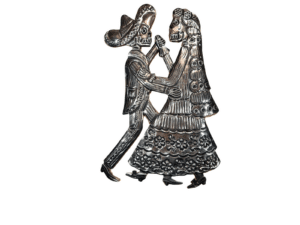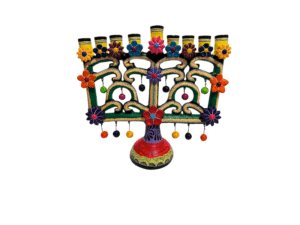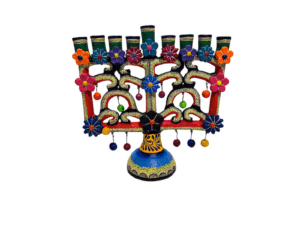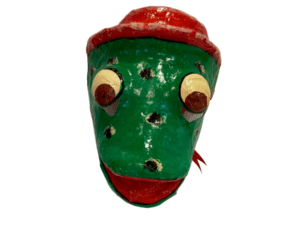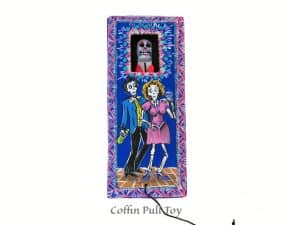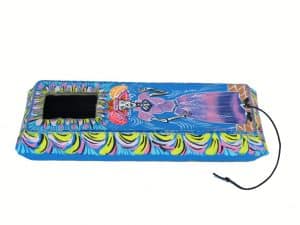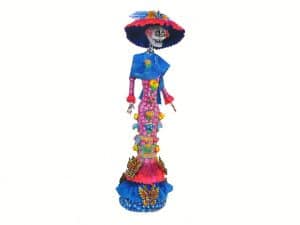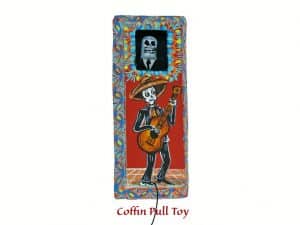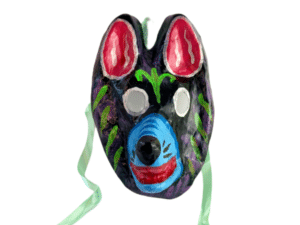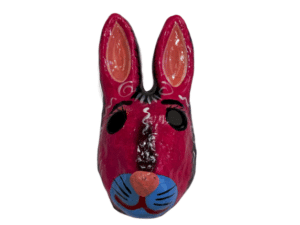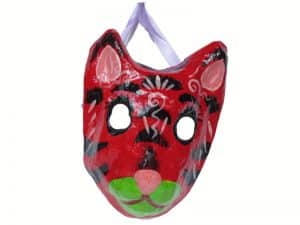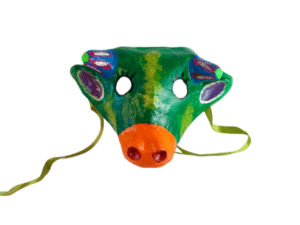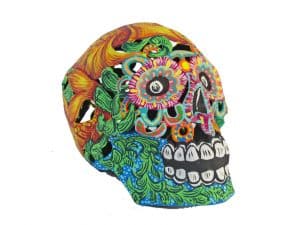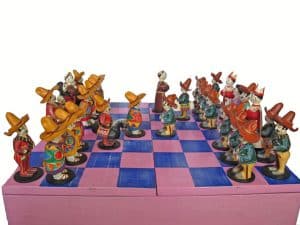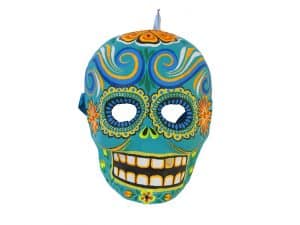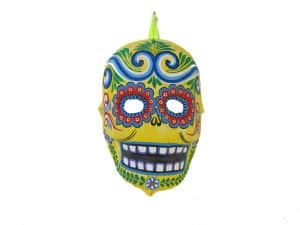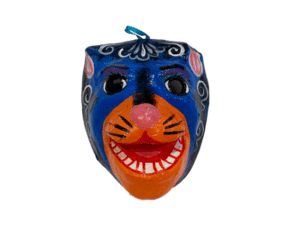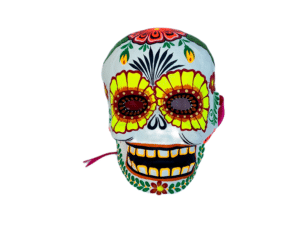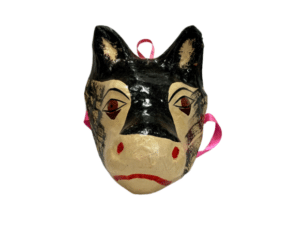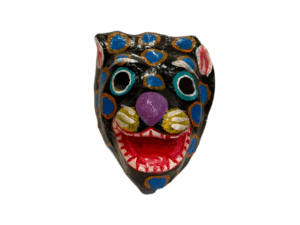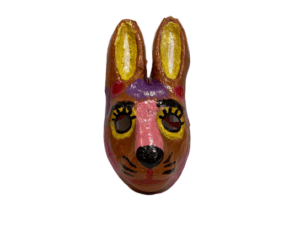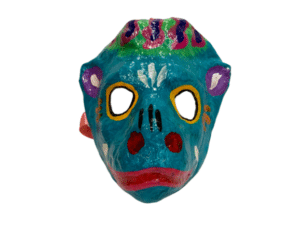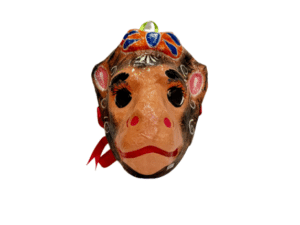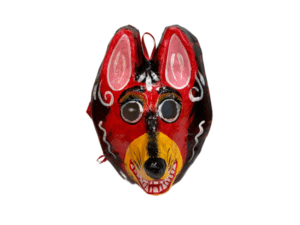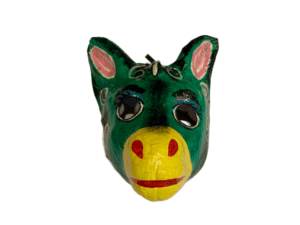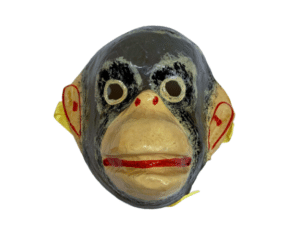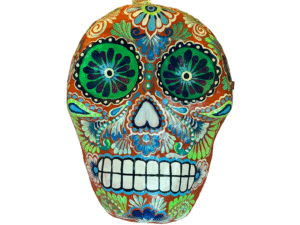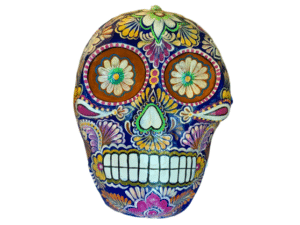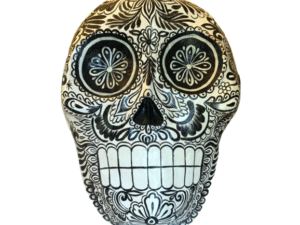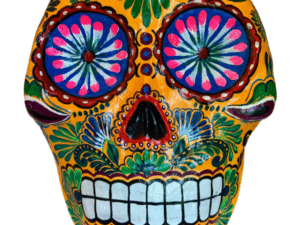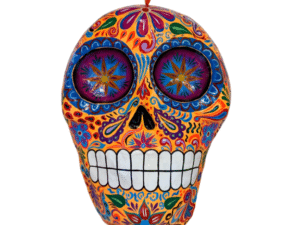Paper Mache Art
Mexican Paper Mache
Our travels around Guanajuato have connected us to three renowned makers of paper mache art, one of Mexico’s most traditional art forms. Since the days of Spanish rule in the early 17th century, the country’s catroneros, as they were called, have been making colorful art from strips of discarded paper, soaked in a soup of flour and water. The creations range from masks and religious figures, to piñatas, Day of the Dead Catrinas and the towering human forms called mojigangas. Take a look at our evolving collection, and enjoy the work here by Pedro Hernandez Cruz, Betzabe Orozco Segoviano, and Francisco de Jesús Juárez Mújica.
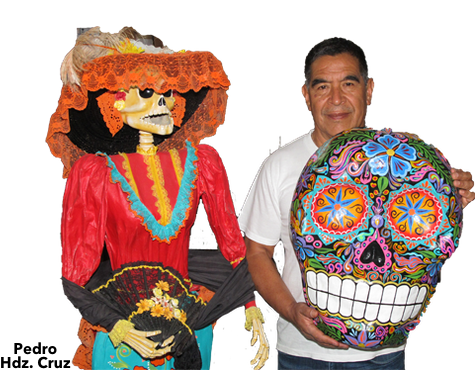
Your Title Goes Here
Your content goes here. Edit or remove this text inline or in the module Content settings. You can also style every aspect of this content in the module Design settings and even apply custom CSS to this text in the module Advanced settings.
Read More About Paper Mache Art
Paper mache sculptures are one of Mexico’s most traditional art forms, originating back in the Spanish colonial days of the 1600s. It was, at first, a means of making inexpensive yet durable objects for use in various ceremonies of the Catholic church. The craft was most developed in central Mexico. In cities such as Mexico City and Celaya, particular families took up the trade, adapting and developing it for new uses, down through the generations. Like other forms of Mexican Folk Art, the raw materials are plentiful and inexpensive. Paper mache artwork is generated with scrap paper and cardboard – old newspapers and boxes, discarded manilla wrapping paper. What is of most value is priceless: the artist’s talent, drive and creativity.
Many of Mexico’s paper mache artists work with a simple, age-old recipe of torn strips of discarded paper, soaked in a soup of flour and water. The recipe is simply two parts water to one part flour, whisked until it is the consistency of pancake batter. Artists soak the bits of paper in this goopy paste until the paper is droopy and wet. Depending on the object to be made, a mask for example, the artist uses a ceramic mold and presses multiple small, saturated strips of paper into the greased mold. The strips are applied over-lapping each other and smoothed down to form a packed layer. The usual process is three layers of pressed paper, allowing 24 hours of drying time between each.
When it’s completely dry, the artist removes the paper mache mask from the mold. Now it is ready for painting. First step is to paint the exterior with a white primer. Then, using colorful acrylic paints, the paper mache artist applies the creative details and facial expression to the mask. The last step is to apply a transparent, protective coat of varnish or to spray it with a glossy coat of polyurethane.
How strong is paper mache? The finished sculpture is tough, rigid and lightweight, as if it were made of a durable plastic.
Paper Mache Mexican Folk Art
In Mexico, makers of paper mache figures are also known as cartonería craftsmen. Over many generations, these artisans have produced a wide variety of items important in the country’s cultural and religious celebrations. These include figures of Judas Iscariot, as large as 35 feet tall, which are paraded through the streets and then burned on Holy Saturday. This tradition continues in places like Mexico City, Celaya and Toluca. Another form of giant, popular figures are the mojigangas, towering papier-mâché human forms created over a hollow, wicker frame. They are worn on the head and shoulders of a dancer hidden inside.
A Day of the Dead celebration is not complete without the addition of colorfully-painted paper mache skulls, dangly skeletons with moveable arms and legs and little cardboard coffins with a skull that peeks out when a string is pulled. And on any day of the year, no Mexican birthday party is complete without a paper mache piñata. Shaped like an animal, clown or a big star, the hollow figures are decorated with colorful crepe paper and filled with candy, fruit and other prizes for the blindfolded children who compete at breaking open the piñata.
Famous Paper Mache Artists
Perhaps the most celebrated Mexican paper mache artists are members of the Linares family in Mexico City. Pedro Linares began the family business in the 1930s, making piñatas and other figures. A turning point in his career came later that decade when, at the age of 30, he became sick and had a hallucinatory dream filled with strange, threatening animals who came after him shouting the word, “alebrije.” After he recovered, he molded and painted the figures he remembered, calling them alebrijes. His mythical creatures painted in bright colors, soon attracted the attention of other artists in Mexico, including the woodcarvers in Oaxaca, who began making their own versions of alebrijes with copal wood. His skeletal figures commissioned for the 1968 Olympics in Mexico City, and a 1975 documentary film, “Pedro Linares: Artisano de Cartón brought him international fame. In 1990, the Mexican government awarded him its distinguished National Prize for Arts and Sciences. His family continues to produce their art from workshops close to the Sonora Market in Mexico City.
Among the acclaimed paper mache artists of modern Mexico are:
” Betzabe Orozco Segoviano, working from the Belfina Art Studio in Leon. Her sister, Edith, and their mother Delfina are also makers of imaginative paper mache sculptures. Betzabe’s lifelike figures, such as the skeleton grandmother seated on a chair on our website, are made with a paper mache body, dressed in woven fabric clothing.
” Pedro Hernandez Cruz in San Miguel de Allende has a long-established workshop producing a wide array of day of the dead and alebrije figures, rattles, hearts with wings, children’s toys, and those beautifully hand-painted skull masks that you see here on our webpage.
” Francisco de Jesús Juárez Mújica and his wife Lourdes Alhondiga from Guanajuato city make the most beautiful, detailed and colorful paper mache Catrina dolls I’ve yet to see. We have several of them on our website, along with Francisco’s skulls, coffin boxes and an amazing Alebrije creature.
Showing 1–28 of 42 results
-
Green Frog Mask
Size: 9.5 inches long x 7 inches wide x 3 inches deep
This Green Frog Mask is made of paper machê so it is light weight. Hand-painted with a green base and given a clear coat to produce a nice sheen. This child’s mask can be hung on a wall or worn. The eyes are open so one can see while wearing it. Please note: The eye openings are small. They are well placed but the sight line is smaller than our other masks. It is handmade by Pedro Hernandez Cruz in his workshop Originales Papel Maché in San Miguel de Allende, Mexico.
SKU: PA_01$34.00 -
Coffin Pull Toy w/couple illustration
Paper mache coffin with a skull that pops up when you pull the string. Traditional Mexican Day of Dead toy. Each coffin pull toy is uniquely designed by the artist; all are equally beautiful.
Coffin measures 6 3/4 inches long by 3″ wide. Hand-painted and signed by Francisco de Jesus Juarez. He is a well-renowned artist in Guanajuato, and each of his coffins is unique.
SKU: PA_14$18.50 -
Coffin Pull Toy With Catrina Illustration
Size: 6.75 inches long x 3 inches wide
The Coffin Pull Toy With Catrina illustration is hand-painted and signed by Francisco de Jesus Juarez. He is a well-renowned artist in Guanajuato, and each of his coffins is unique and all are equally beautiful. Pull the string and a skeleton skull pops up in the window. Traditional Day of the Dead toy.
SKU: PA_16$18.50 -
La Catrina Figurine, Paper Maché
Size: 12 inches tall
La Catrina Figurine is made of Paper Maché . It is eye catching with bright colors and intricate designs. It is decorated with white lilies and orange butterflies. Very durable The head, hat and hands detach for shipping. Handcrafted in Guanajuato, Mexico by Francisco Juarez. Signed on the base.
SKU: PA_19$175.00 -
Coffin Pull Toy With Skeleton Guitarist
Size: 6.75 inches long x 3 inches wide
The Coffin Pull Toy With Skeleton Guitarist illustration is a traditional Day Of The Dead toy. When the string is pulled, a skeleton’s skull pops up in the window of the coffin. It is hand-painted and signed by Francisco de Jesus Juarez. He is a well-renowned artist in Guanajuato, and each of his coffins is unique.
SKU: PA_15$18.50 -
DOG MASK, child’s size, paper maché art
Child-size dog face mask made of paper mache. Hand-painted in black, pink and blue, then given a durable, glossy coating.
Dog mask measures 10 inches tall, by 6.5″ wide by 4.5″ deep. Includes tie ribbon on backside. Wear it, or hang it on a wall.
SKU: PA_26$22.50 -
Pink Rabbit Mask
Size: 12 inches tall x 5.5 inches wide x 4 inches deep
This Pink Rabbit Mask is made of paper machê so it is light weight. Hand-painted with a pink base and given a clear coat to produce a nice sheen. This child’s mask can be hung on a wall or worn. The eyes are open so one can see while wearing it. It’s a great mask for Halloween! It is handmade by Pedro Hernandez Cruz in his workshop Originales Papel Maché n San Miguel de Allende, Mexico.
SKU: PA_28$34.00 -
Red Cat Mask
Size: 8.5 inches tall x 5.5 inches wide x 3 inches deep
This Red Cat Mask is made of paper machê so it is light weight. Hand-painted with an red base and given a clear coat to produce a nice sheen. This child’s mask can be hung on a wall or worn. The eyes are open so one can see while wearing it. It’s a great mask for Halloween! It is handmade by Pedro Hernandez Cruz in his workshop Originales Papel Maché n San Miguel de Allende, Mexico.
SKU: PA_34$34.00 -
Green Bull Mask
Size: 8 inches tall x 11.5" wide x 4" deep
This Green Bull Mask is made of paper machê so it is light weight. Hand-painted with a green base and given a clear coat to produce a nice sheen. This child’s mask can be hung on a wall or worn. The eyes are open so one can see while wearing it. It’s a great mask for Halloween! It is handmade by Pedro Hernandez Cruz in his workshop Originales Papel Maché n San Miguel de Allende, Mexico.
.
SKU: PA_31$34.00 -
Skull with Fish Motif
Size: 5 inches long x 3.5 inches tall
The Skull with Fish Motif is handcrafted by Francisco Juarez. The green skull is decorated with orange fish images.
SKU: PA-36$68.00 -
Sale!
Chess Set Mexican Theme, Paper Maché Figures, Super-Size, Handcrafted in Mexico
Size: Box measures 31.5 x 31.5 x 7 inches tall. Chess pieces are between 7 and 9 inches tall.
Chess set is super-sized! The large chess box stores the chess pieces which are made of paper maché. The wooden case has compartments to hold the figurines safely and securely. Each piece is initialed on the bottom by the artist. Each of the 32 pieces is unique! Made by Pedro Hernandez Cruz in San Miguel de Allende. Note: This is an oversized & heavy item, and shipping costs will reflect that.
SKU: PA_50$1,300.00 -
Turquoise Skull Mask
Size: 8 inches tall bx 5.5 inches wide x 3 inches deep
The Turquoise Skull Mask is made from paper maché. Hand-painted and given a clear coat to produce a nice sheen. This child’s mask can be hung on a wall or worn. The eyes are open so one can see while wearing it. It’s a great mask for Halloween! It is handmade by Pedro Hernandez Cruz in his workshop Originales Papel Maché n San Miguel de Allende, Mexico.
SKU: PA_47$40.00 -
Yellow Skull Mask
Size: 8 inches tall x 5.5 inches wide x 3 inches deep
The Yellow Skull Mask is made from paper maché. Hand-painted and given a clear coat to produce a nice sheen. This child’s mask can be hung on a wall or worn. The eyes are open so one can see while wearing it. It’s a great mask for Halloween! It is handmade by Pedro Hernandez Cruz in his workshop Originales Papel Maché n San Miguel de Allende, Mexico.
SKU: PA_48$40.00 -
Animal Child’s Mask
Size: 8.5 inches tall x 7 inches wide x 4 inches deep
This animal child’s mask is made of paper machê so it is light weight. Hand-painted with a blue base and given a clear coat to produce a nice sheen. This child’s mask can be hung on a wall or worn. The eyes are open so one can see while wearing it. It’s a great mask for Halloween! It is handmade by Pedro Hernandez Cruz in his workshop Originales Papel Maché n San Miguel de Allende, Mexico.
SKU: PA_52$34.00 -
White Skull Mask
Size: 8 inches tall x 6 inches wide
The White Skull Mask is made from paper maché Hand-painted and given a clear coat to produce a nice sheen. This child’s mask can be hung on a wall or worn. The eyes are open so one can see while wearing it. It’s a great mask for Halloween! It is handmade by Pedro Hernandez Cruz in his workshop Originales Papel Maché n San Miguel de Allende, Mexico.
SKU: PA-10$40.00 -
Cow Mask
Size: 9.5 inches tall x 7 inches wide x 4 inches deep
This Cow Mask is made of paper machê so it is light weight. Hand-painted with a cream and black base and given a clear coat to produce a nice sheen. This child’s mask can be hung on a wall or worn. The eyes are open so one can see while wearing it. Please note: The eye openings are small. They are well placed but the sight line is smaller than our other masks. It is handmade by Pedro Hernandez Cruz in his workshop Originales Papel Maché in San Miguel de Allende, Mexico.
SKU: PA-55$34.00 -
Black Animal Mask
Size: 8.5 inches tall x 7 inches wide x 3 inches deep
This Black Animal Mask is made of paper machê so it is light weight. Hand-painted with a black base and given a clear coat to produce a nice sheen. This child’s mask can be hung on a wall or worn. The eyes are open so one can see while wearing it. It is handmade by Pedro Hernandez Cruz in his workshop Originales Papel Maché in San Miguel de Allende, Mexico.
SKU: PA_56$34.00 -
Brown Rabbit Mask
Size: 13.5 inches tall x 6.5 inches wide x 4 inches deep
This Brown Rabbit Mask is made of paper machê so it is light weight. Hand-painted with a brown base and given a clear coat to produce a nice sheen. This child’s mask can be hung on a wall or worn. The eyes are open so one can see while wearing it. It’s a great mask for Halloween! It is handmade by Pedro Hernandez Cruz in his workshop Originales Papel Maché n San Miguel de Allende, Mexico.
SKU: PA_57$34.00 -
Blue Monkey Mask
Size: 8 inches tall x 7.5 inches wide x 3 inches deep
This blue monkey mask is made of paper machê so it is light weight. Hand-painted with a blue base and given a clear coat to produce a nice sheen. This child’s mask can be hung on a wall or worn. The eyes are open so one can see while wearing it. It is handmade by Pedro Hernandez Cruz in his workshop Originales Papel Maché in San Miguel de Allende, Mexico.
SKU: PA_58$34.00 -
Female Monkey Mask
Size: 8.5 inches tall x 7 inches wide x 3 inches deep
This Female Monkey Mask is made of paper machê so it is light weight. Hand-painted with a skin-toned base and given a clear coat to produce a nice sheen. This child’s mask can be hung on a wall or worn. The eyes are open so one can see while wearing it. It is handmade by Pedro Hernandez Cruz in his workshop Originales Papel Maché in San Miguel de Allende, Mexico.
SKU: PA_59$34.00 -
Red Dog Mask
Size: 9.5 inches tall x 6.75 inches wide x 3 inches deep
This Red Dog Mask is made of paper machê so it is light weight. Hand-painted with a red base and given a clear coat to produce a nice sheen. This child’s mask can be hung on a wall or worn. The eyes are open so one can see while wearing it. It’s a great mask for Halloween! It is handmade by Pedro Hernandez Cruz in his workshop Originales Papel Maché in San Miguel de Allende, Mexico.
SKU: PA_60$34.00 -
Burro Mask
Size: 9 inches tall x 9 inches wide x 3 inches deep
This Burro Mask is made of paper machê so it is light weight. Hand-painted with a green base and given a clear coat to produce a nice sheen. This child’s mask can be hung on a wall or worn. The eyes are open so one can see while wearing it. It is handmade by Pedro Hernandez Cruz in his workshop Originales Papel Maché in San Miguel de Allende, Mexico.
SKU: PA_11$34.00 -
Monkey Mask
Size: 8 inches tall x 8 inches wide x 3 inches deep
This monkey mask is made of paper machê so it is light weight. Hand-painted with a gray base and given a clear coat to produce a nice sheen. This child’s mask can be hung on a wall or worn. The eyes are open so one can see while wearing it. It is handmade by Pedro Hernandez Cruz in his workshop Originales Papel Maché in San Miguel de Allende, Mexico.
SKU: PA_24$34.00 -
Tan Skull Mask, 22 inches
Size: 22 inches tall x 16.5 inches wide x about 5 inches deep
This tan skull mask art features a tan base with brightly colored designs. It is made of paper maché, hand-painted and given a clear coat to produce a nice sheen. This Day of the Dead decor can be hung on a wall or tied around an item such as a statue. It has a satin ribbon loop at top for hanging and long satin ribbon ties in the back. It is handmade by Pedro Hernandez Cruz in his workshop Originales Papel Maché. Note: This is an oversized item and shipping costs will reflect that.
SKU: PA_64$165.00 -
Blue Skull Mask, 22 inches
Size: 22 inches tall x 16.5 inches wide x about 5 inches deep
This blue skull mask art features a bright blue base with brightly colored designs. It is made of paper maché, hand-painted and given a clear coat to produce a nice sheen. This Day of the Dead decor can be hung on a wall or tied around an item such as a statue. It has a satin ribbon loop at top for hanging and long satin ribbon ties in the back. It is handmade by Pedro Hernandez Cruz in his workshop Originales Papel Maché. Note: This is an oversized item and shipping costs will reflect that.
SKU: PA_66$165.00 -
White Skull Mask, 22 inches
Size: 22 inches tall x 16.5 inches wide x 5 inches deep
This white skull mask art features a white base with black designs. It is made of paper maché, hand-painted and given a clear coat to produce a nice sheen. This Day of the Dead decor can be hung on a wall or tied around an item such as a statue. It has a satin ribbon loop at top for hanging and long satin ribbon ties in the back. It is handmade by Pedro Hernandez Cruz in his workshop Originales Papel Maché. Note: This is an oversized item and shipping costs will reflect that.
SKU: PA_67$165.00 -
Bright Orange Skull Mask, 22 inches
Size: 22 inches tall x 16.5 inches wide x 5 inches deep
This bright orange skull mask art features a bright orange base with colorful designs. It is made of paper maché, hand-painted and given a clear coat to produce a nice sheen. This Day of the Dead decor can be hung on a wall or tied around an item such as a statue. It has a satin ribbon loop at top for hanging and long satin ribbon ties in the back. It is handmade by Pedro Hernandez Cruz in his workshop Originales Papel Maché. Note: This is an oversized item and shipping costs will reflect that.
SKU: PA_68$165.00 -
Orange Skull Mask, 22-inch
Size: 22 inches tall x 16.5 inches wide x 5 inches deep
This orange skull mask art features a bright orange base with brightly colored designs. It is made of paper maché, hand-painted and given a clear coat to produce a nice sheen. This Day of the Dead decor can be hung on a wall or tied around an item such as a statue. It is handmade by Pedro Hernandez Cruz in his workshop Originales Papel Maché. Note: This is an oversized item and shipping costs will reflect that.
SKU: PA_07$165.00



